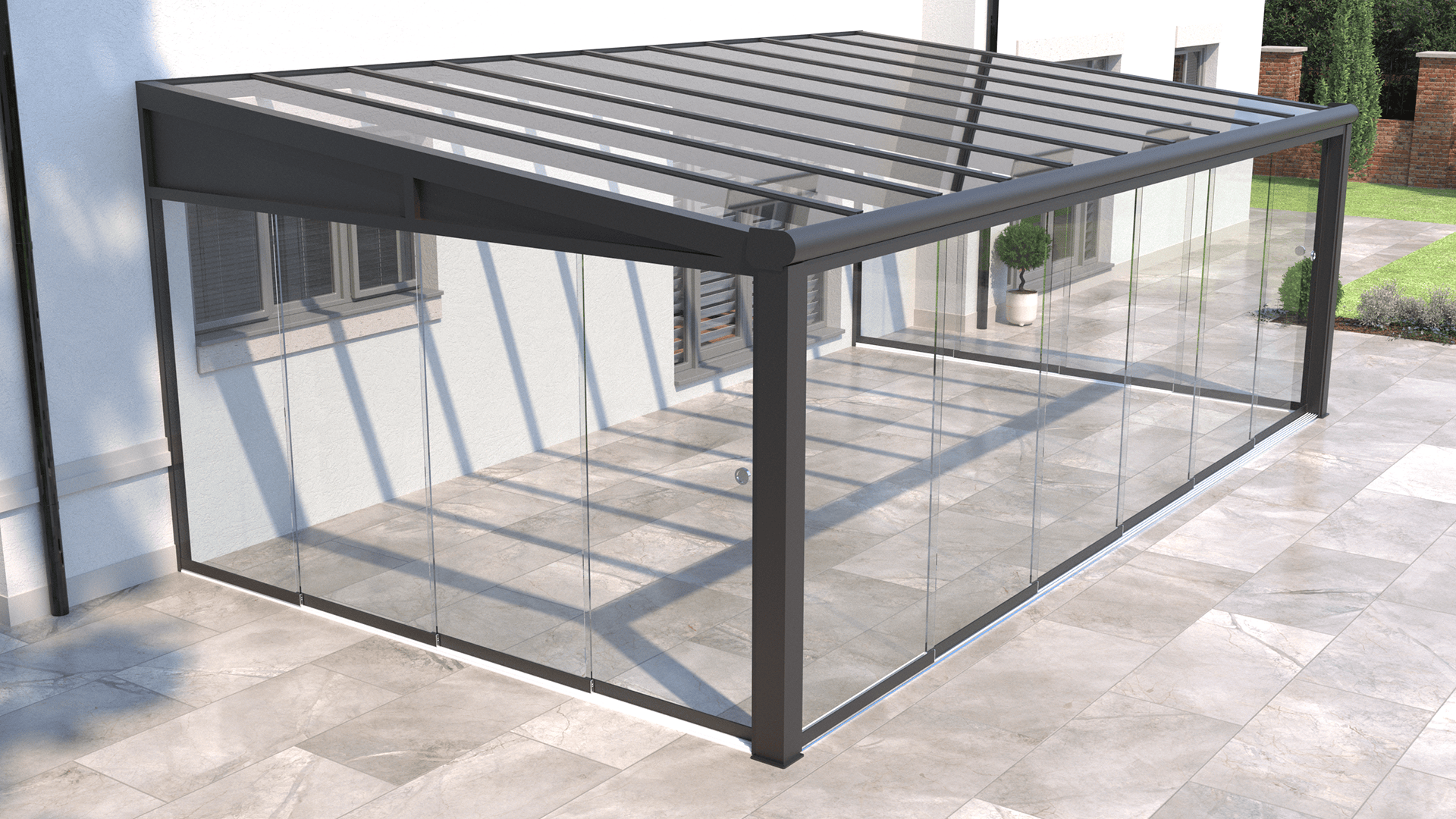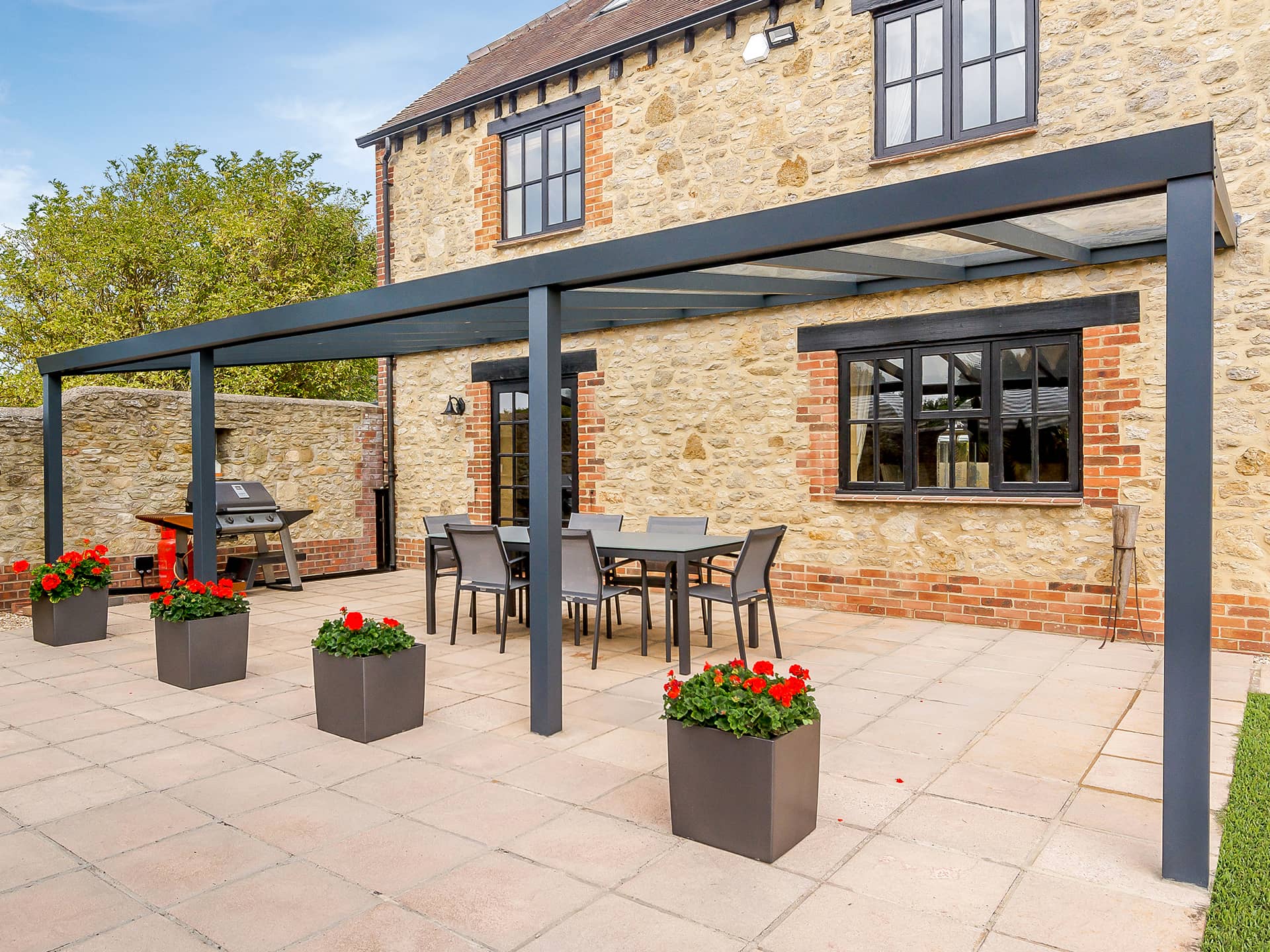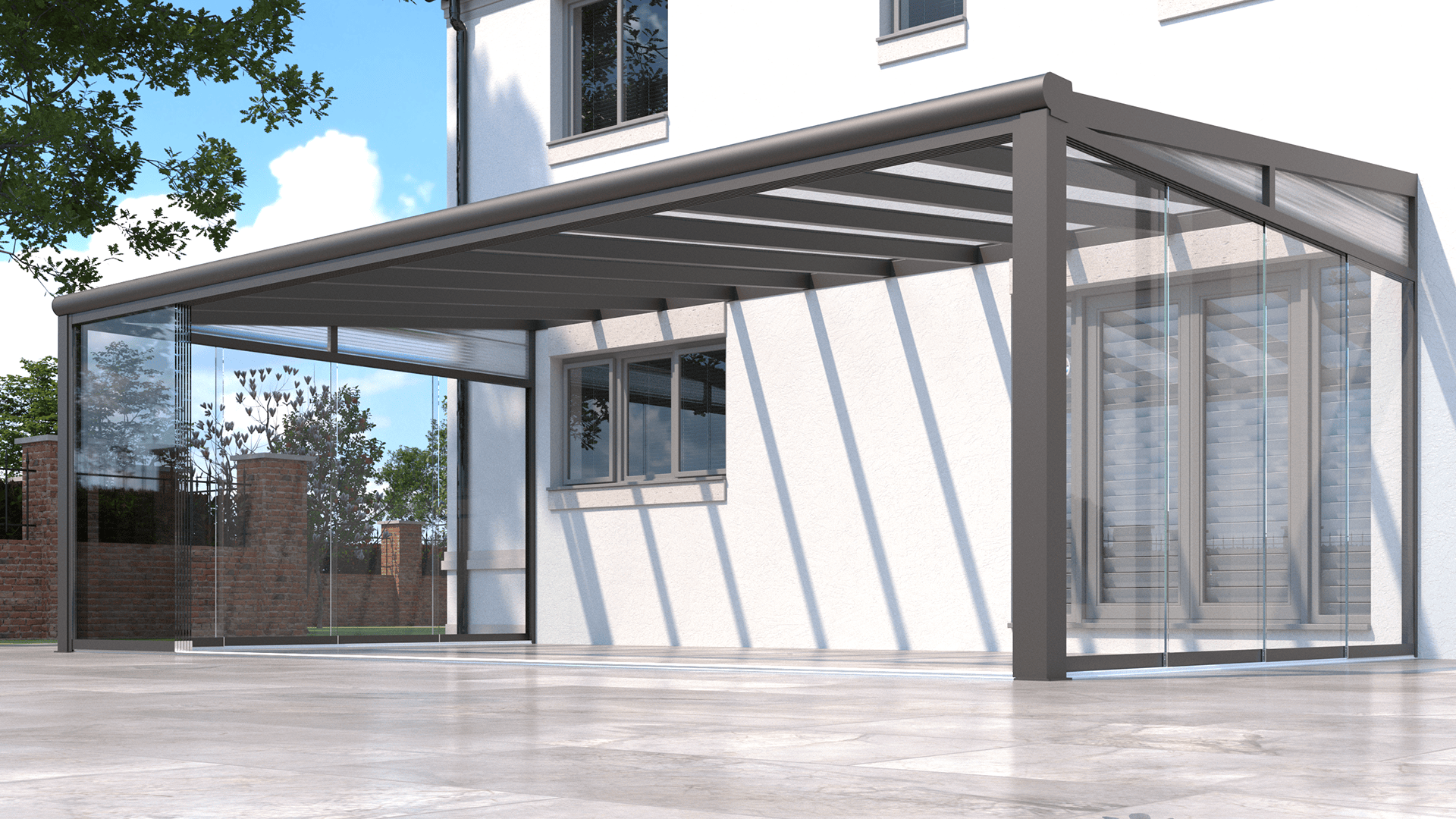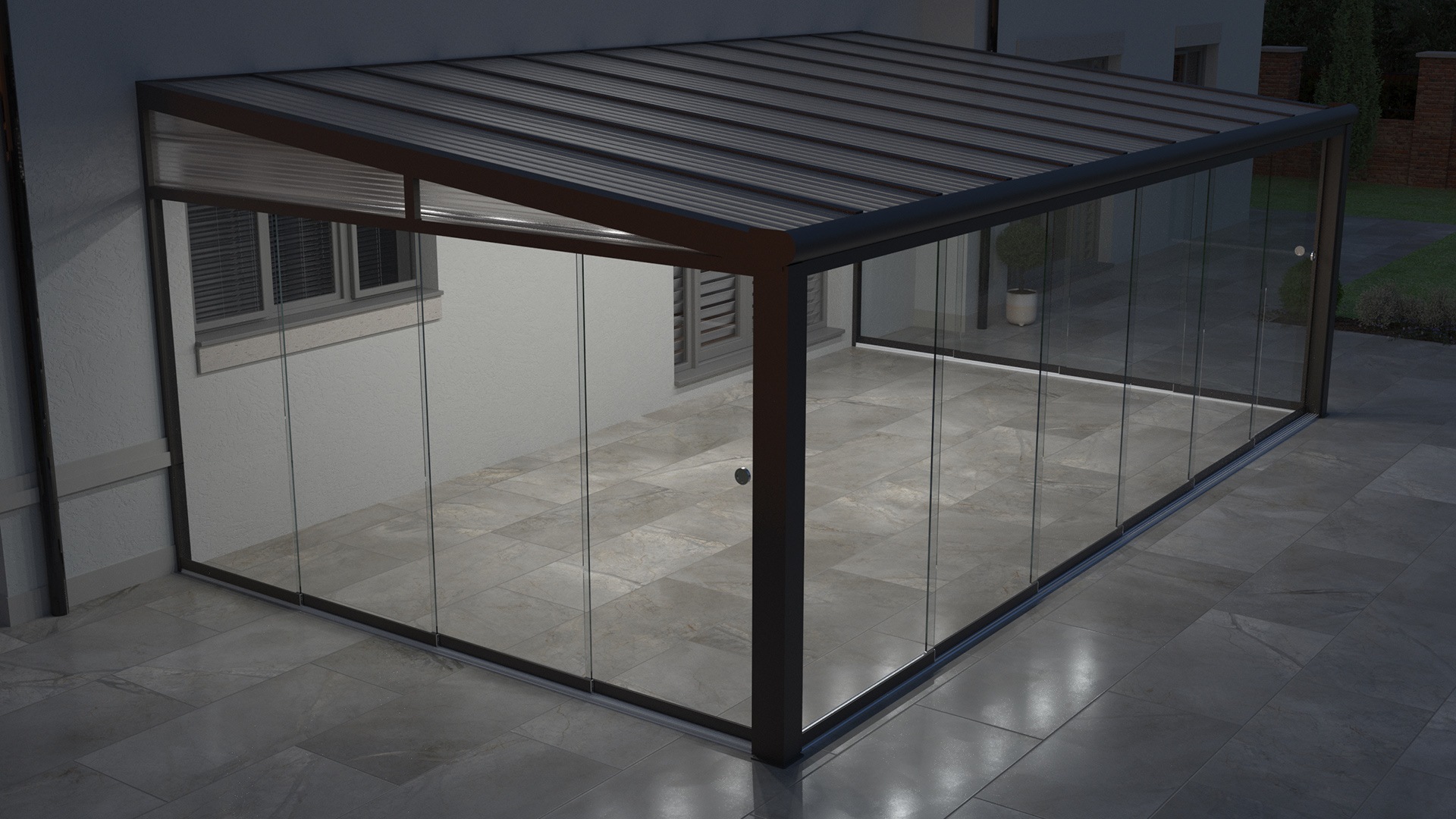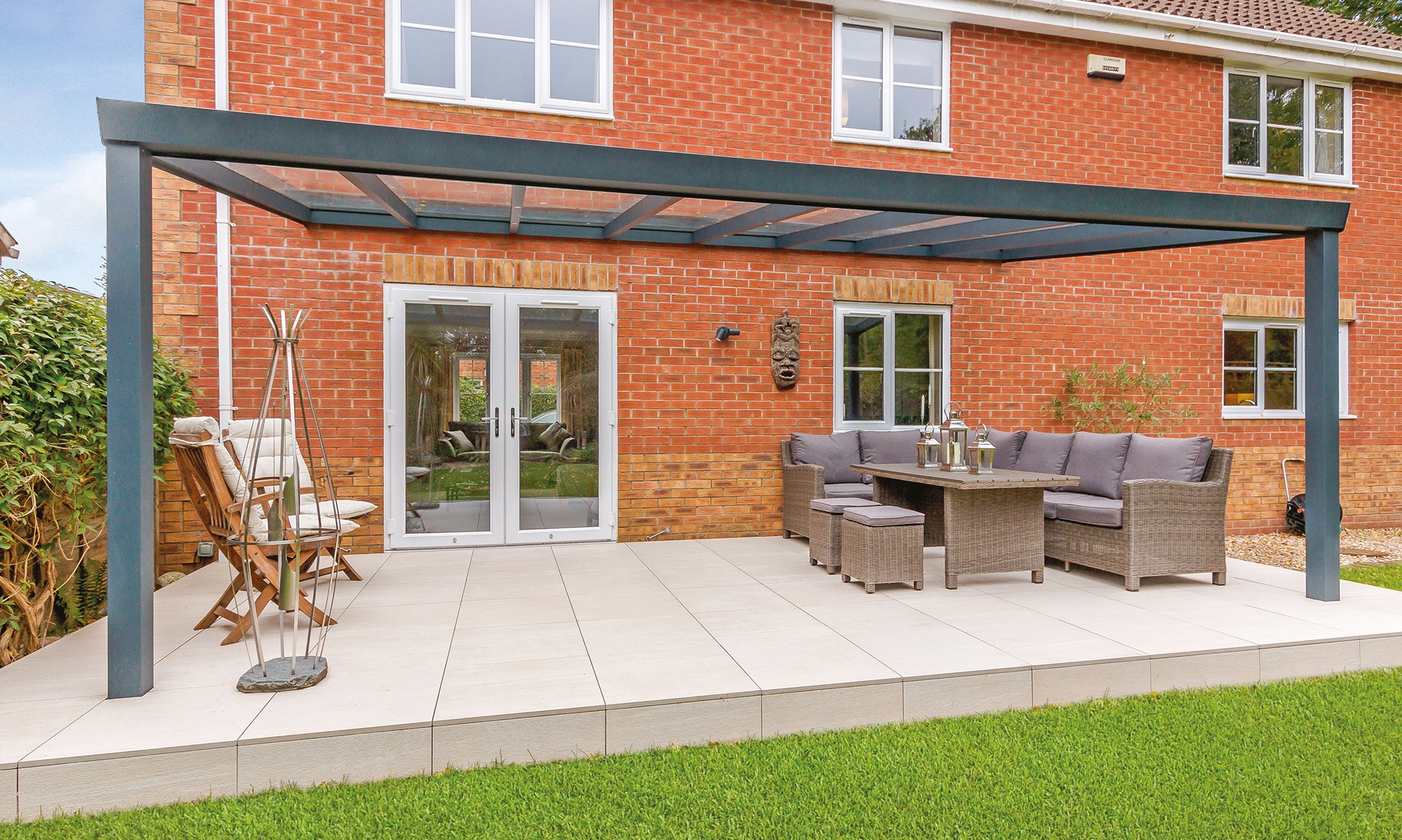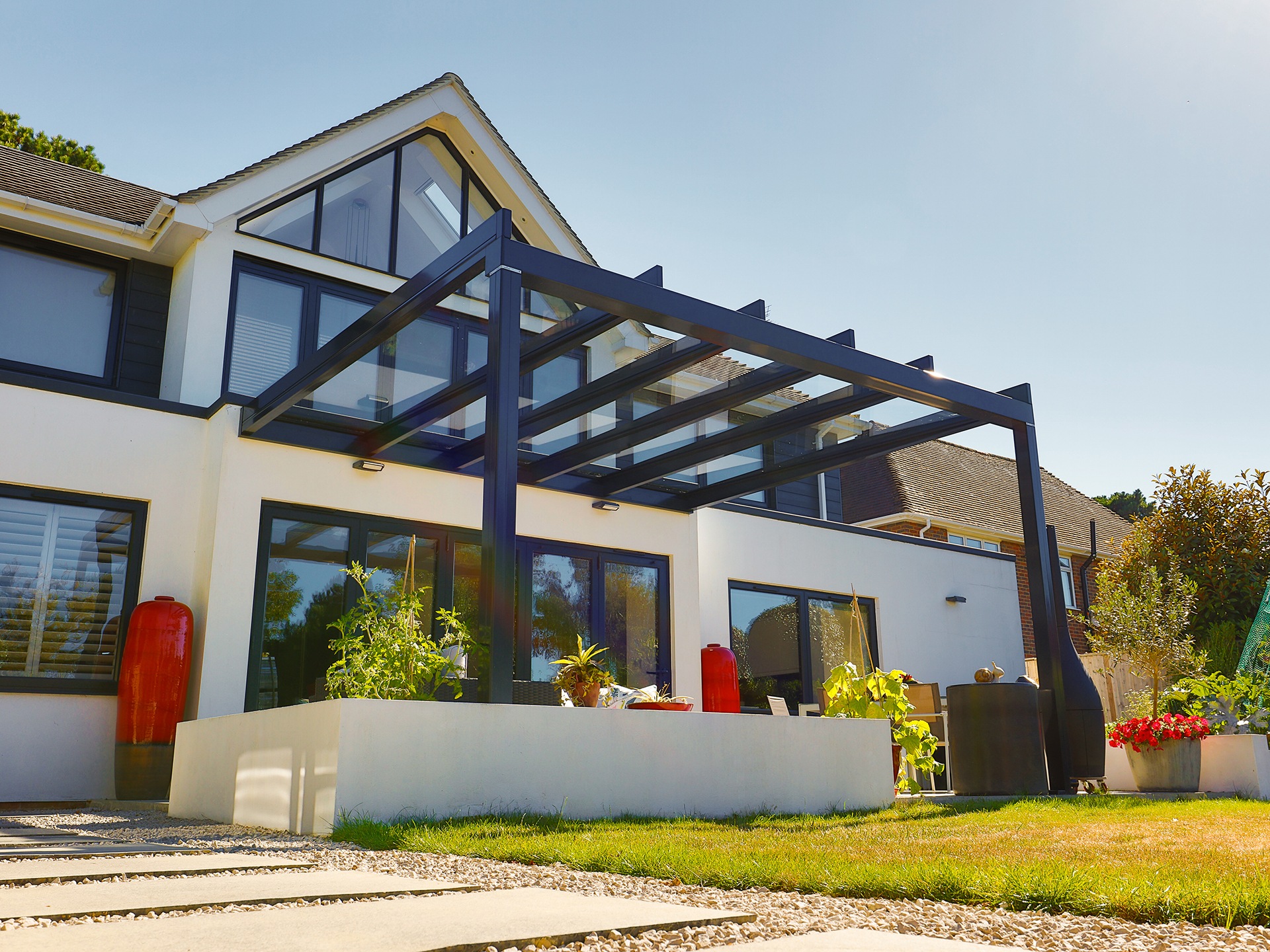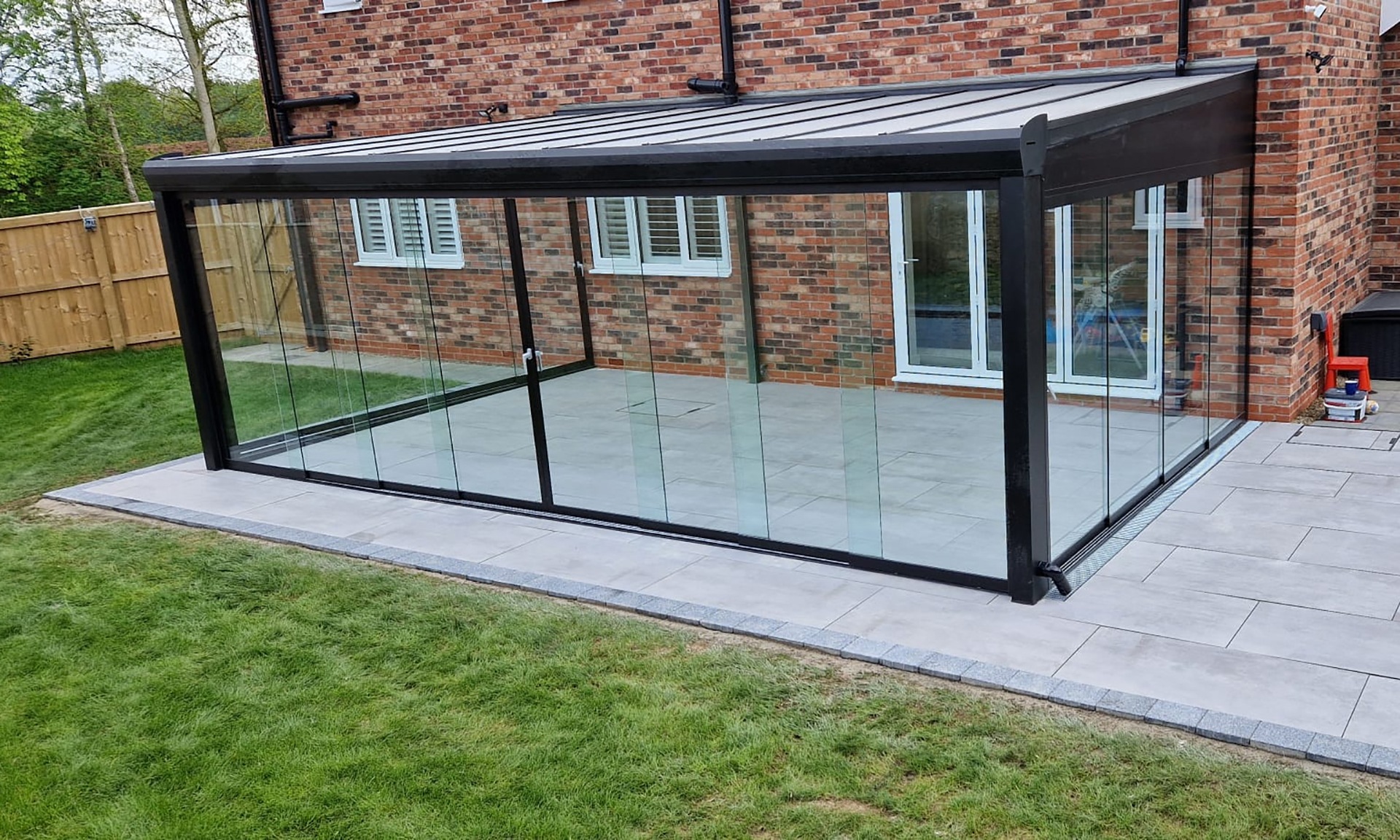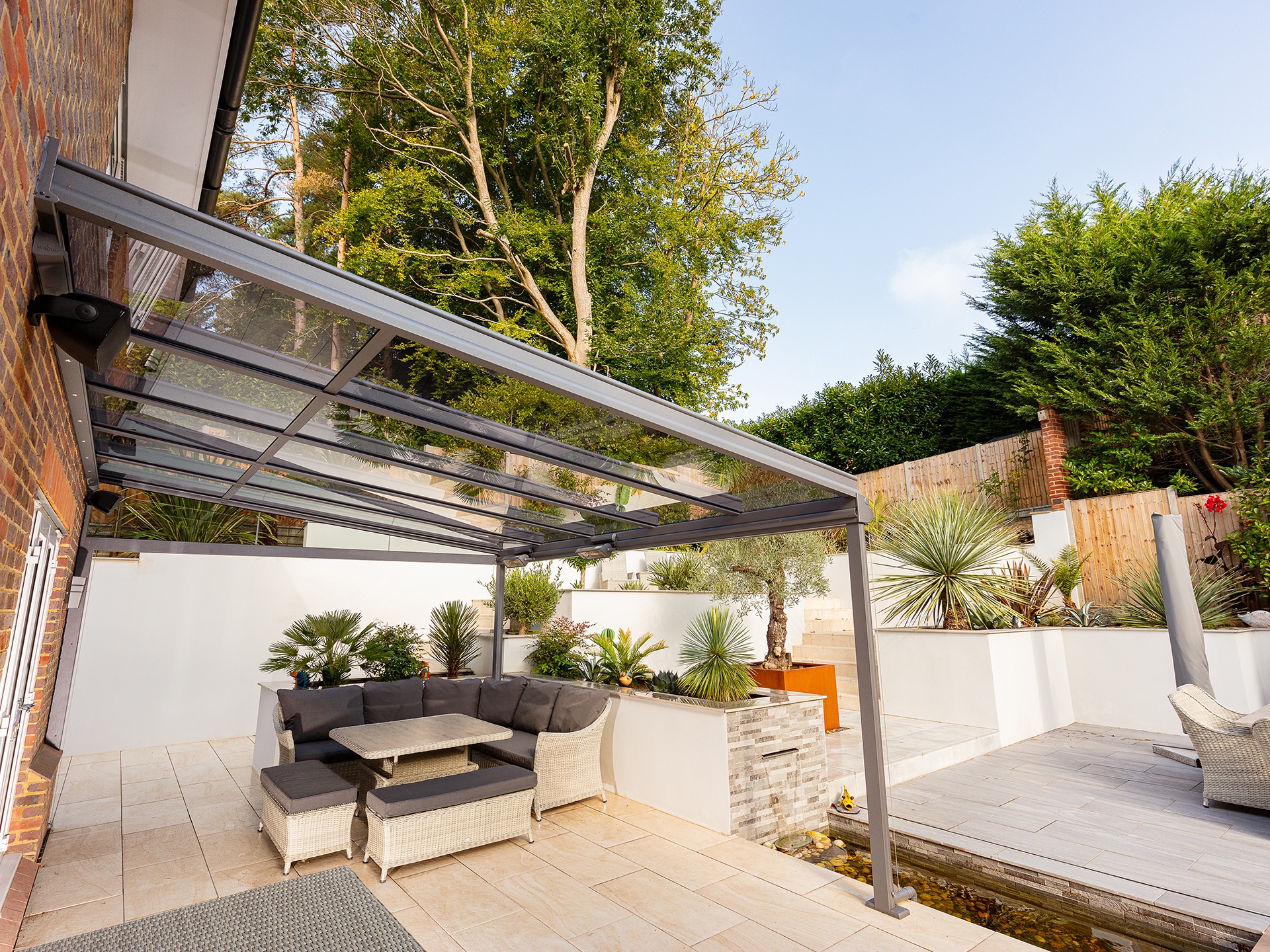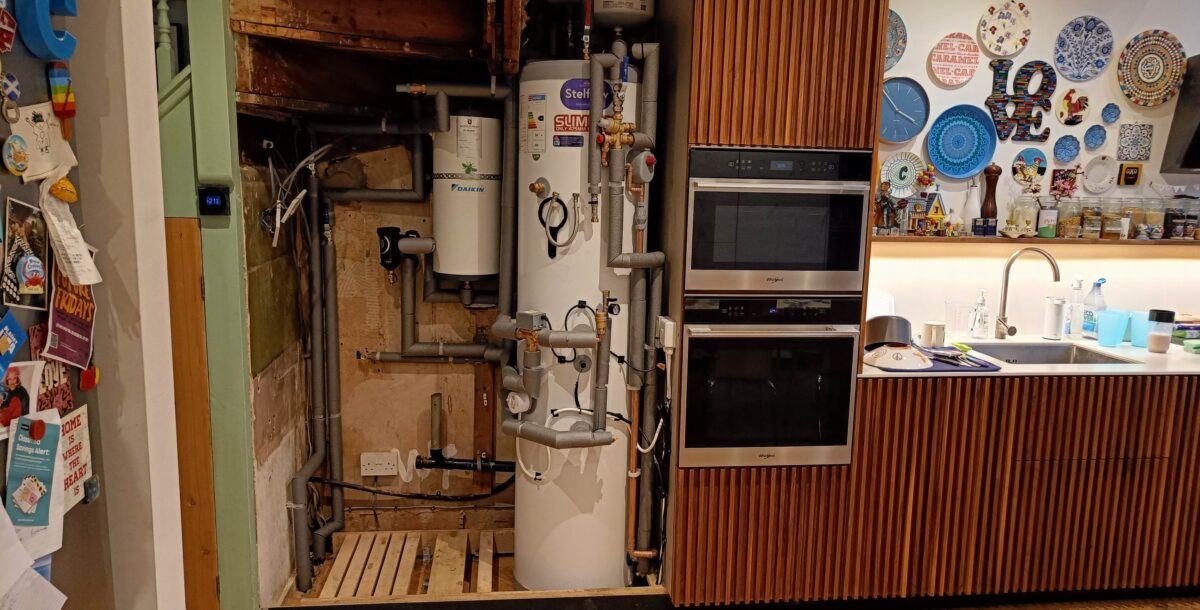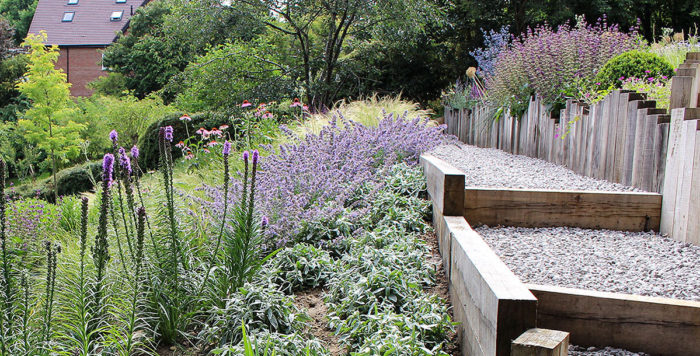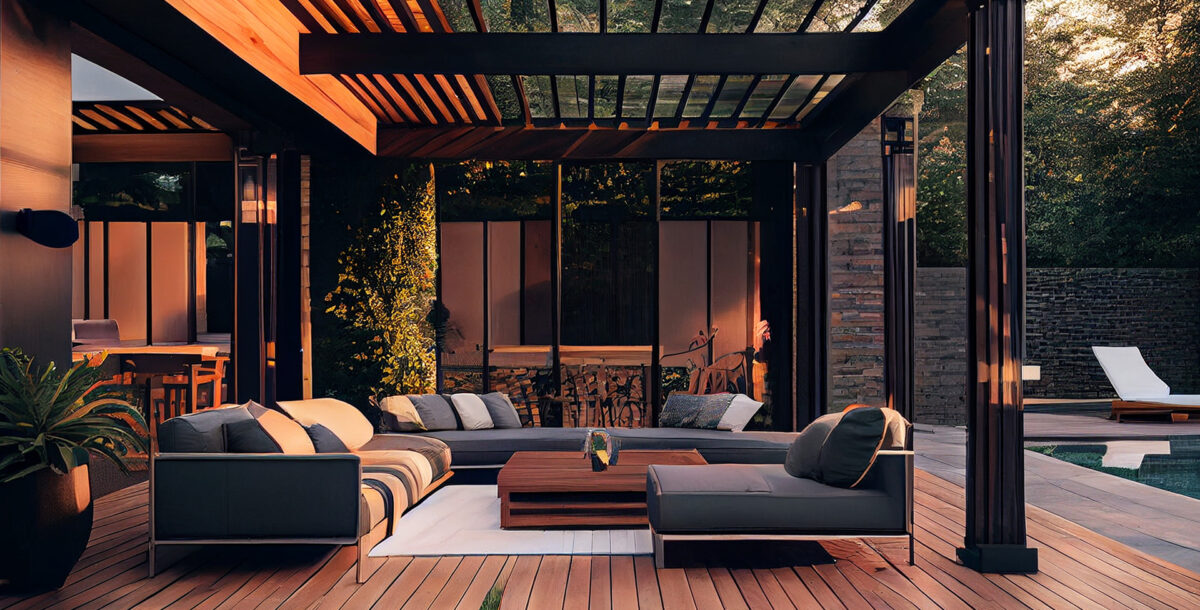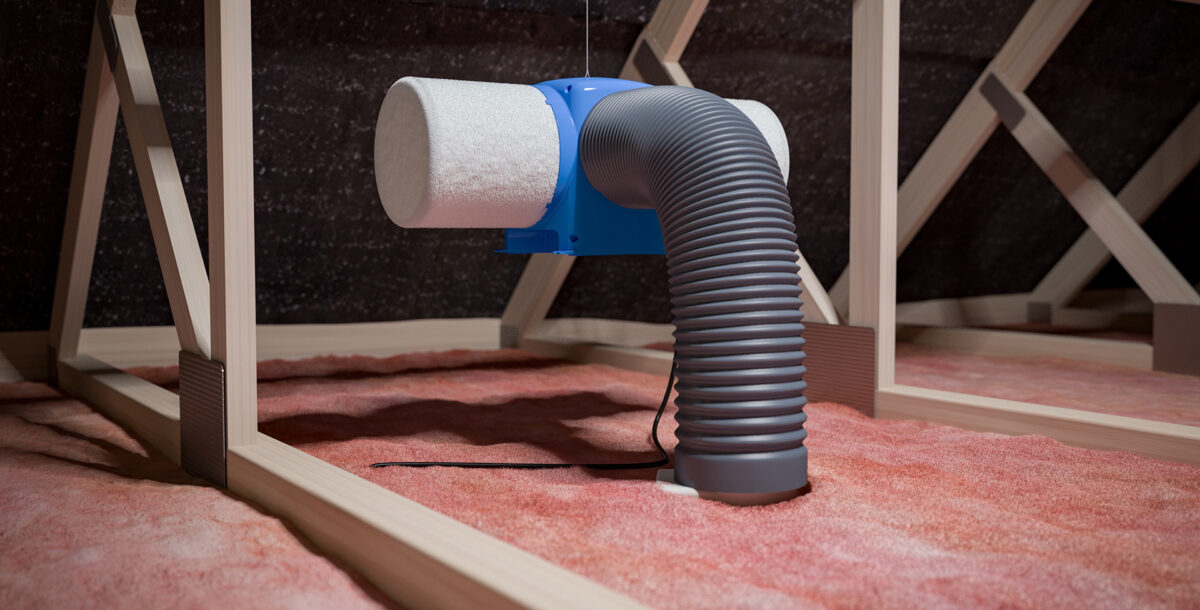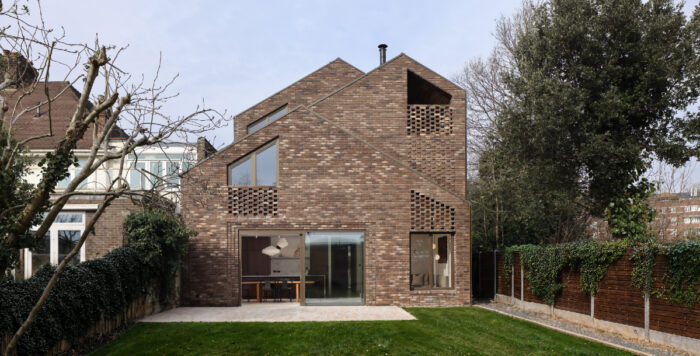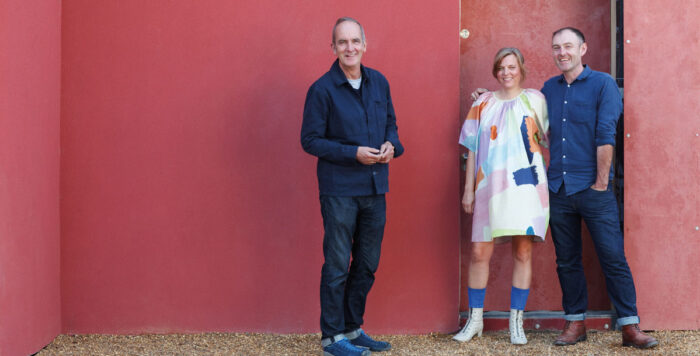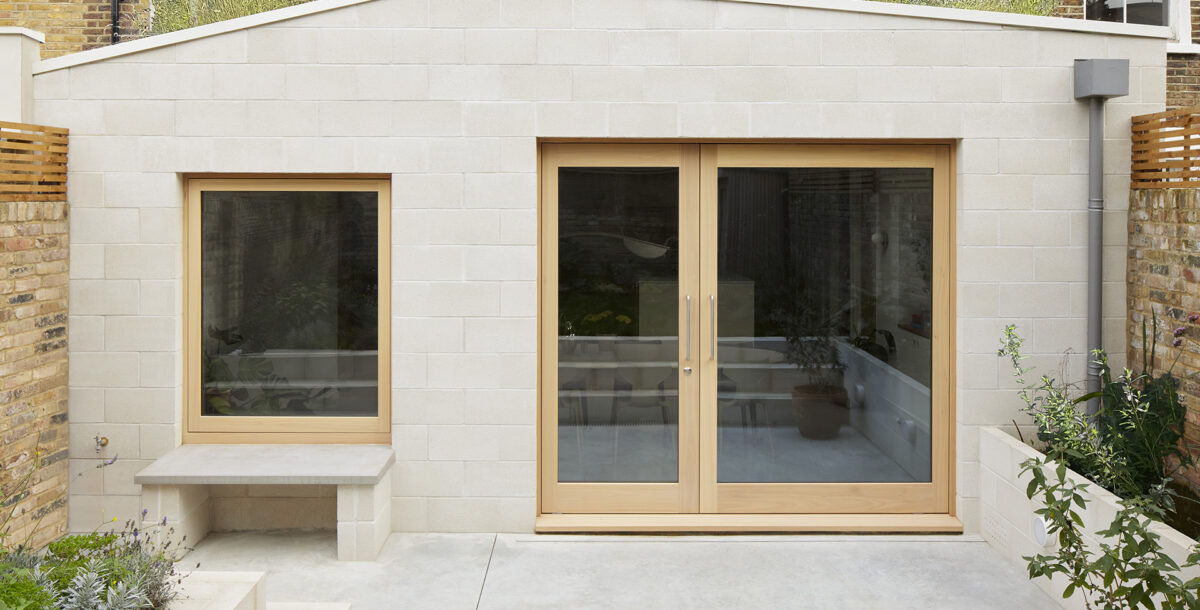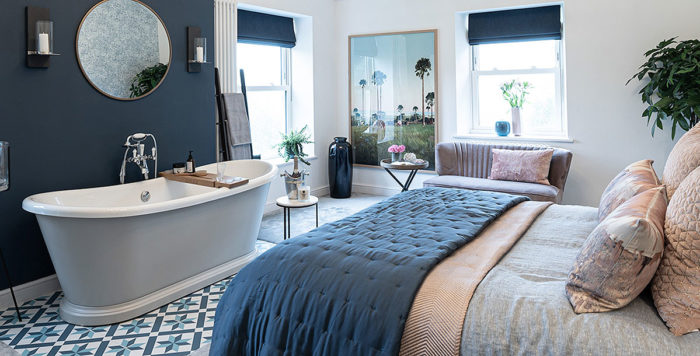Glass verandas and glass rooms
Contemporary glass-roofed verandas and glass rooms are some of the most fashionable extensions. Visually unobtrusive, they let you enjoy outdoor living all year round. We’ve got everything you need to know before you buy…
“Veranda” or “verandah”? Let’s get that out of the way first. In British English, for a long time, the word “verandah” had an “h” at the end. And some people still use that spelling. But many others have dropped the “h’’. However you spell it though, a veranda is a roofed structure, usually open-sided, and usually attached to a house.
A veranda typically consists of a gently sloping roof (nowadays often made of toughened glass) attached to a house wall on one side and held up at the other side by supports. Verandas are often put up over a patio or area of decking outside bifold or sliding doors. Most manufacturers also sell sliding glass doors and glass sides for their verandas to turn them into enclosed verandas, called glass rooms or modern conservatories. Glass verandas or rooms can extend up to a maximum of about 5m from the house, depending on the model, and can be as wide as you want.
Tom Wall, of Wall Architecture, says, “Glass verandas are certainly growing in popularity, and it’s not hard to understand why. Not only are they cost-effective, but they also add a stylish, contemporary touch to most properties, providing a practical, covered external space that enhances both lifestyle and home value.”
Like other patio-cover options like awnings and pergolas, a simple glass veranda or canopy can be a way to let you enjoy your patio when it’s raining. Unlike pergolas or awnings, basic glass verandas don’t provide much shade, just shelter from the rain. However, many veranda manufacturers offer blinds or sunshades that fit underneath their veranda to use when the sun gets too strong. Some also offer vertical blinds or awnings for shade and privacy.
Tom says, “One of the significant advantages of glass verandas is their ability to integrate with existing external landscaping. Provided your current patio or decking is in good condition, it can be repurposed, saving both time and money. On top of that, verandas can also incorporate solar shading to control heat and ensure privacy, making them comfortable for year-round use.” Often it is possible to lift individual patio slabs to set the veranda roof supports into the ground, then cut the slabs to shape and replace the cut sections around the new support.
Style
Verandas are available with elaborate, ornamental Victorian-style supports, which suit period properties, and in clean-lined contemporary designs. If your house is particularly large, you could even choose to put an elegant glass-roofed loggia (covered walkway) down one entire side of the property.
The supports for most of these structures are made from powder-coated aluminium. Most companies sell a few colour options: white, grey and black. But some firms allow you to choose the colour of powder coating from the full range of RAL colours.
Kit or bespoke
There are lots of different options available when it comes to choosing a glass veranda, depending on your budget and requirements. At one end of the scale, you can buy a basic veranda kit, consisting of polycarbonate roof panels and upright supports, to assemble yourself. At the top end of the market, companies will send around their rep to measure up, then design and build you a bespoke modern conservatory.
Tom says, “This will perhaps come as a surprise to some, but constructing a glass veranda is a relatively straightforward task that can be managed by local tradespeople or even as a DIY project for the more hands-on homeowner. This approach can save on labour costs and make the project more affordable. Many companies will be able to build a glass veranda, so obtaining multiple quotes to find the best deal is not only advisable but easy to do.”
Glass room
The glass room is a contemporary take on the conservatory. Once the supports and glass veranda roof are in place, sides to form the room are added using full-length glass panels and sliding doors. This creates an outdoor glass room you can use most of the year. Mervyn Montgomery, from Hampton Conservatories, points out the benefits, “Being connected to nature and sunlight can generate a multitude of mental and physical benefits. Regular exposure to natural light during the day and a darker environment at night can enhance your circadian rhythm, aiding better sleep quality. The natural environment is great for our mental health. It has been proven that being in green spaces such as woodland – or a garden – reduces the stress hormone cortisol and raises endorphins and dopamine production, both of which are associated with happiness. The Japanese have a word for this, Shinrin-yoku, meaning ‘taking in the forest atmosphere’ or ‘forest bathing’.
“Biophilia is this deep-rooted human inclination to seek connections to nature. Studies have proven that this connection can be made without leaving the home. A glass room blurs the lines between home and garden, facilitating that all-important connection to nature, no matter the weather. Many homeowners who invest in glazed rooms comment on how they feel more connected to the changing of the seasons than they did before they added their extensions.”
Glass room vs conservatory
Glass rooms are different from traditional conservatories because they don’t tend to have extensive foundations or partial brick walls. The selling point is the floor-to-ceiling glass, offering uninterrupted views of the garden. Another advantage of the glass room is that it doesn’t block light going into the house through any windows or doors it encloses.
Materials
Most glass verandas are made of toughened glass with powder-coated aluminium supports. A cheaper option for the roof is clear polycarbonate. You can also buy veranda kits where the uprights are made from timber.
All about the glass
Glass technology has moved on since many older conservatories were built, meaning the “too hot in summer, too cold in winter” syndrome suffered by lots of these traditional conservatories no longer has to be a problem. Today you can choose glass with better insulation properties. For the summer, there are also various special coatings available that will cut out UV rays and glare from the sun. Just be aware these won’t necessarily come as standard on all verandas and glass rooms. You will need to ask your supplier.
Mervyn says, “Glare is not usually a significant issue when selecting vertical glazing, but the overhead sun on cloudless summer days can make it a major consideration when it comes to glass roofs. To deal with glare, several glass solutions, such as tints and coatings, have been developed that filter and reflect the sunlight, allowing natural daylight in but reducing the possibility of glare. For example, the very soft great tint of grey anti-sun glass is unnoticeable when installed but significantly reduces glare without darkening the room. Coatings can also be retrofitted to existing glass.”
He continues, “Technological advances now allow coated glass to reflect the radiation from the sun preventing it from heating the room too much. The effectiveness of solar-control glass at preventing radiation from passing through is described using g-values. Generally low g-value glass would be specified in a south-facing roof, whilst glass with a higher g-value may be more appropriate for a north-facing roof.”
Planning permission
Tom Wall says, “For most properties, planning permission is not typically required for glass verandas either, making them more appealing as people don’t have to deal with bureaucratic delays and can simply focus on the design and functionality of their verandas.”
As usual, though, there will be situations where you should consult your planning authority, for example, if you are thinking of putting a glass veranda:
- in front of your house
- facing a road
- in the grounds of a listed building
- in a conservation area
- other designated areas such as the Norfolk Broads or a World Heritage Site
- on a flat or maisonette
- on a commercial property
Maintenance
Condensation can be a problem in glass rooms as the temperature differential between the outside and inside of the room can cause water to form on the inside of the glass. To counteract this, it helps to improve the ventilation.
The glass panels in some rooms have small gaps between them which allows for ventilation. Where the panels are more closely fitted, some manufacturers recommend opening the doors of your room regularly for ventilation during the winter. Special ventilation panels can be added to many models of glass rooms to allow for greater air circulation. Opening these will help reduce the air temperature in summer and reduce condensation in winter.
A soft cloth and a pH-neutral cleaner are recommended to clean glass verandas.
Security
In many cases the door locks provided on glass room doors won’t be security locks, so you shouldn’t rely on them to keep people out of your home. Always lock the door from your home into the glass room when you’re not at home, and don’t leave valuables on show in the room.
Sustainability
Both glass and aluminium can be recycled at the end of a glass veranda’s life, and, as a semi-permanent structure, it doesn’t require extensive carbon-intensive concrete foundations. Polycarbonate is a less sustainable choice as it is made from oil and is quite difficult to recycle at present.
Furnishing a glass room
Unless you are spending a lot of money and getting a proper glazed extension built, it’s best to think of a glass room as part of your outdoor space. Some people choose outdoor furniture, and this doesn’t have to mean taking a style hit because there is so much great-looking, design-led indoor-outdoor furniture available these days. Mervyn says, “Due to technological advancements in glass, homeowners do not need to be as concerned with the furniture they choose for a glazed extension as they might have been in the past. Rattan materials were often selected because, although they could be prone to fading, the natural shades were no less attractive if they became lighter in the sun and loose-fitting cushions were easy to clean and replace. Fast-forward to today and most of our customers select a regular fabric sofa for their glazed extensions to get maximum use and maximum comfort from their new room.”
Lighting
Mervyn offers the following tips for lighting a glass room:
- Create a focal point with a statement overhead feature light.
- Use wall lights to frame the room from within. Wall sconce lights are the perfect way to filter light up and down the exterior brick walls, reflecting just enough of a warm glow from the glass ceiling above. Choosing down-lighters, instead of shaded wall lights, helps increase the light but avoids any reflections from surrounding glass.
- Think about different heights to cascade light to different levels. Light the overall room with a centrally placed ceiling light, chandelier, or pendant. For secondary lighting, consider a taller floor lamp to illuminate a corner or behind an armchair adding a highlight, or a table lamp to add a gentle glow at mid-height within the room.
- Create cosy corners with directional spotlight lamps. You can balance the light levels with a mix of floor lamps in corners and table lamps on top of key furniture pieces.
Using the space
Most people use their glass veranda or room for relaxing or dining. A glass room can be a great place to observe nature in your garden or to let children play. You could also grow plants – just as people do in traditional glass houses. To avoid the feeling you’re sitting in a greenhouse, stick to a few plants and choose some of the stylish patio-growing furniture options that are available rather than tatty plant pots and grow bags.
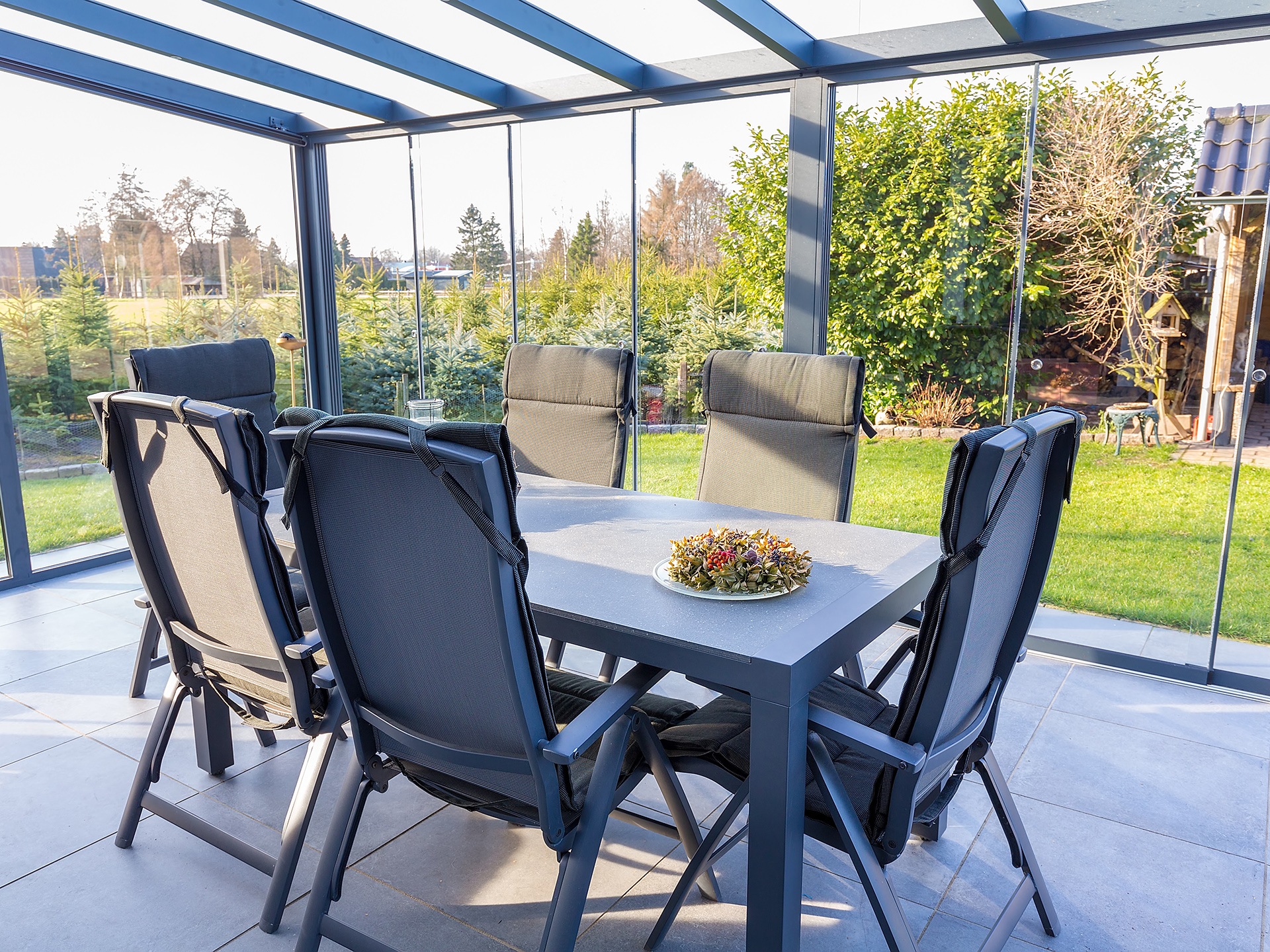
Image credit: Adobe Stock
You could put a hot tub under a glass veranda – or even in a glass room, providing you open the door when you’ve used it to prevent condensation. A glass canopy can also make a good carport.
Cost
You can buy a small veranda kit with a polycarbonate roof for £1,000-2,000. A large bespoke glass room could cost up to £50,000. Generally speaking, you get what you pay for. If you are thinking of investing in a glass room, see if you can talk to someone who already owns one like the model you are considering, so you can hear how it performs in situ.

